Housing Action Plan Context

Researched and developed from November 2021 to January 2022.
Overview
In 2021-2022 the City of Ketchum conducted a housing needs assessment and extensive community outreach to understand the current unmet housing demand as well as projected need in ten years. Housing needs were defined not only by those without housing but by those in crowded conditions or overpaying for housing. “The Community Need” section of this document is a summary of the key highlights from the 2021/2022 Findings Summary (see Attachment 2 for the full Findings Summary). The housing needs data served as the foundation for building the Housing Action Plan.
The Community Need
The housing needs assessment estimated that the City of Ketchum needs between 660-980 homes in the next 10 years to meet demand. The breakout of how demand was determined is described in the table below. It is expected that this need could be met through a combination of new construction, preserved rentals, and converting existing homes into long-term rentals.
Additionally, for all of Blaine County, (including Ketchum) approximately 4,700 to 6,400 new, preserved, or converted housing units will be needed over the next 10 years. This projection emphasizes why county-wide collaboration and housing efforts are critical to addressing the housing crisis.
city of KETCHUM projected 10-year housing need
Build new, convert, or stabilize about 660 to 982 homes in the next 10 years.
Does not include the 335 “lost” renter households from 2010 to 2019.
| Description | Historic Growth (1% Annually) | High Growth (3% Annually) | |
|---|---|---|---|
| New Households | New households based on 10-year population growth scenarios. | + 224 | + 556 |
| Current Households | Households in need of stabilization or at risk of displacement: – cost-burdened – experiencing homelessness – overcrowded | 436 | 436 |
| ESTIMATED DEMAND | Could be achieved by: – preserving existing housing – converting units to local-occupied – new construction | ||
| Total projected units needed in next 10 years. | 660 total | 982 total | |
| Projected units needed per year over the next 10 years. | 66 annually | 98 annually |
One trend that greatly contributes to the lack of affordability is that residential development in Ketchum and throughout Blaine County has slowed since the 1980s. This means that with historical population growth and an increase in the seasonal/vacant/short-term rental use of existing housing stock, the supply of homes affordable for owner- and renter-occupancy decreased.
city of KETCHUM residential development by decade
Residential development has slowed.
Year Structure Built — Ketchum Housing Units
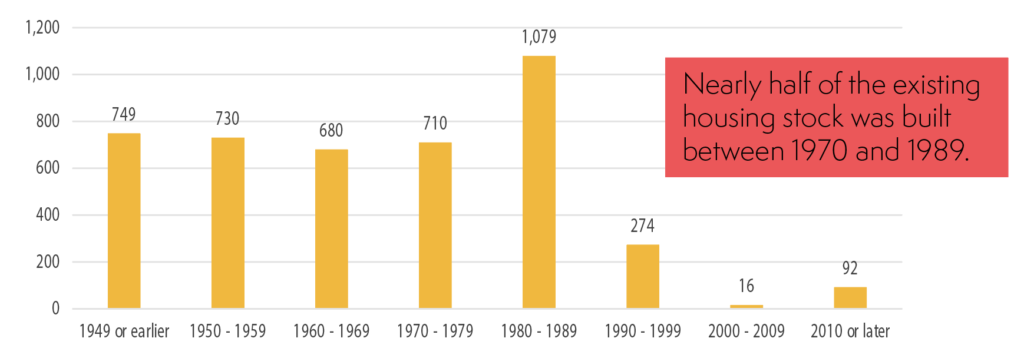
Source: U.S. Census Bureau: American Community Survey 5-Year Estimates (2013-2019), cross-referenced with City of Ketchum building permit data
Low- and middle-income renters have the greatest unmet housing needs.
Ketchum’s workforce primarily consists of low- and middle-income households (under $45,355 per year or $23 per hour) that our local economy depends on. Sixty percent of local renters live in unaffordable housing, meaning they pay more than 30% of their gross/pre-tax income on housing costs. Compounding the problem, Ketchum lost 335 long-term rentals between 2010 and 2019. This is without accounting for pandemic acceleration when Ketchum’s population grew by 25% compared to the historical 1% annual growth. Low-income renters are the most impacted by the high cost of housing. Many low-income households and individuals are one emergency away from experiencing homelessness. A survey of over 1,100 participants who live or work in Blaine County found that 1% of our population is already experiencing homelessness.
Only upper-income households can really afford the ‘market.’
Given current, high housing for-sale and rental prices in Ketchum, market-rate housing is only affordable for upper-income households. Median (market) Ketchum rent is only affordable to households earning more than $107,000 annually ($100,000 for the County).
Sources:
1. U.S. Census Bureau, American Community Survey 5-year Estimates, 2019 for Blaine County. Industry by median earnings in the past 12 months for the full-time, year-round civilian employed population. Blaine County estimates are used to align with federal and state housing programs.
2. Ketchum Housing Matters community survey, Nov. 15, 2021-Jan. 3, 2022
3. U.S. Census: ACS 5-Year Estimates for 2010 and 2019 data
4. U.S. Census Bureau: American Community Survey 5-Year Estimates (2013-2019); Decennial Census Redistricting Data (2020)
5. Ketchum Housing Matters community survey, Nov. 15, 2021-Jan. 3, 2022
6. Blaine County Housing Authority, fiscal year 2019 and 2021. Based on Idaho Mountain Express advertisements
City of Ketchum Housing Mix
Long-term rentals have decreased.
- The proportion of long-term rentals decreased from 31% in 1970 to 10% in 2019
- About 335 long-term rental units were “lost” in Ketchum since 2010, with a significant proportion likely converted to seasonal or short-term use.
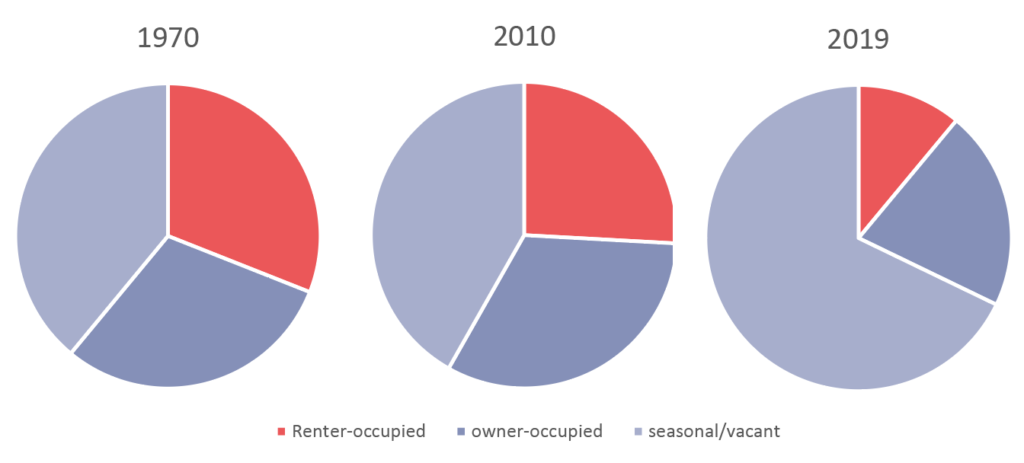
WHAT WE HEARD HIGHLIGHTS
Housing is not affordable
Both renters and homeowners are paying on housing more than is affordable. Renters report being cost-burdened at significantly higher rates than homeowners (60% v. 29%).
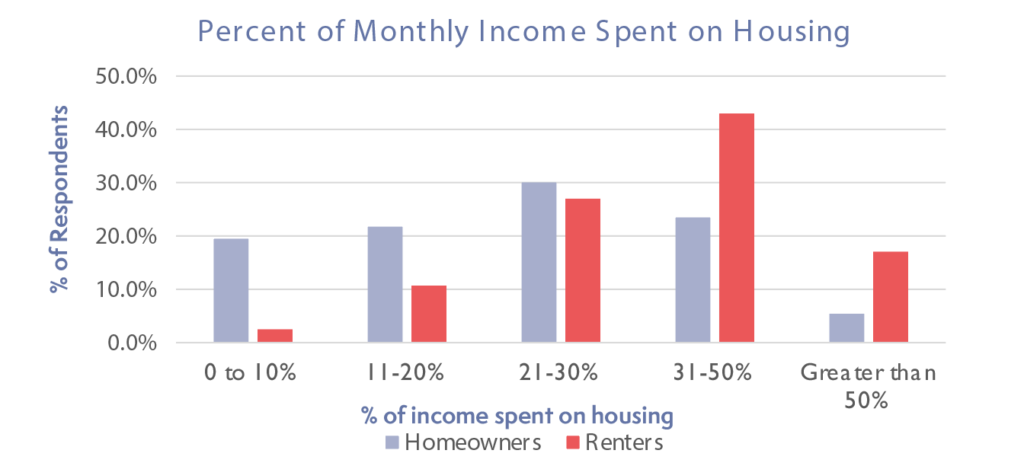
Consistent themes throughout interviews, surveys, and open houses are the breadth of housing crisis impacts Valleywide. Below are key themes of what we heard.
The community’s identity. Sentiment from a variety of interviewees is the sense that Ketchum is losing its identity as the housing market becomes challenging and people move away. Many respondents felt that the pursuit of accessible community housing represents more than a roof over community members’ heads – it’s a quest to maintain the “soul” of the community.
Access to a stable workforce – which is damaging business vitality. Business viability and access to a stable workforce were common ideas shared when interviewees were asked to identify a “key indicator” for the housing environment.
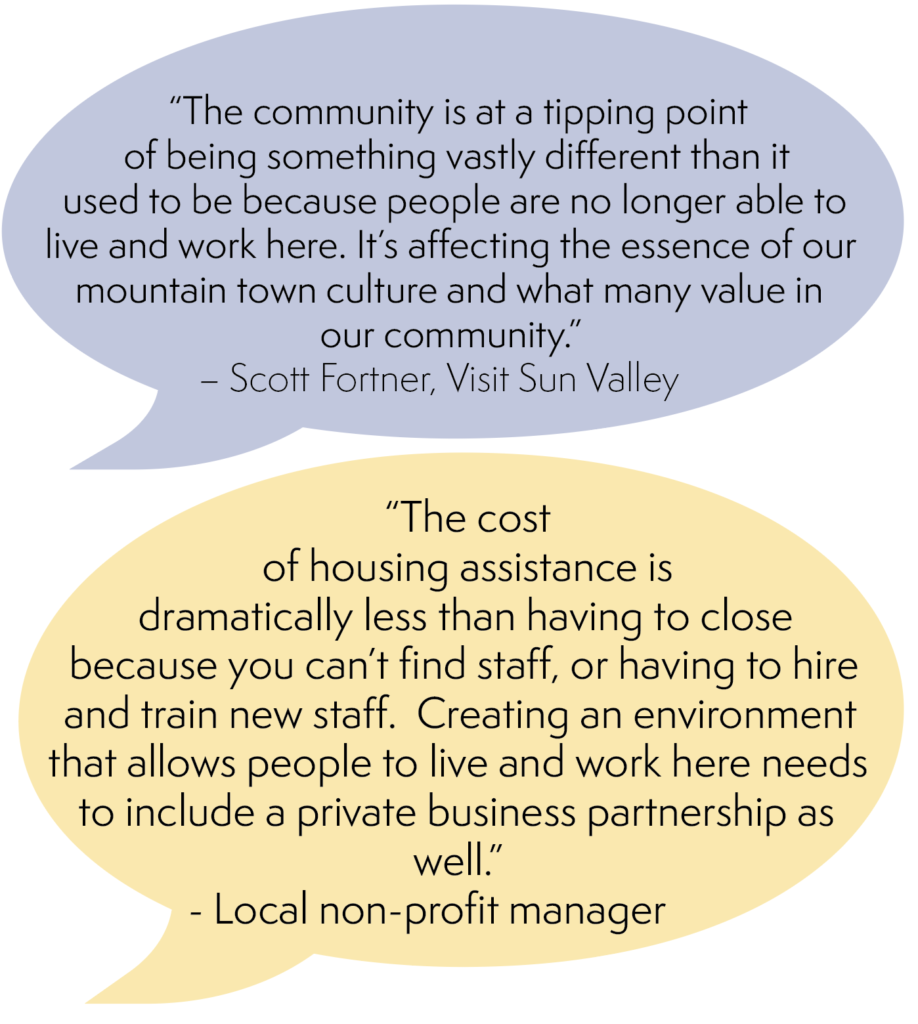
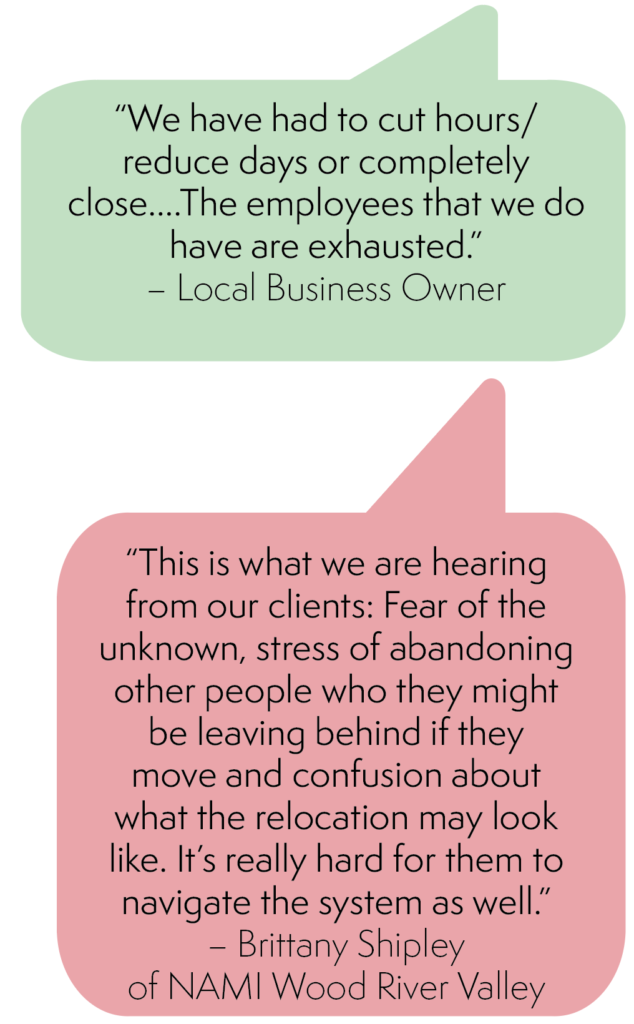
The social, financial, and emotional stability of displaced households and those at risk of displacement. Housing instability is creating financial, social, and emotional challenges for residents across the valley. Displacement and housing instability have mental and physical health impacts. In adults, it increases the likelihood of depression and suicide and has physical impacts. In children, it disrupts development and immune system responses and increases the likelihood of hospitalization.
Especially for those in crisis, stress from housing instability can make it more challenging to navigate nonprofit and social service networks. Respondents indicated that they, or their clients, were often shuffled from one agency to the next in an attempt to access resources. Often these clients would complete a process only to find out that they did not meet the eligibility criteria, which may even specifically screen out some of the most vulnerable community members.
Sources:
1. Ketchum Housing Matters interviews of over 30 community members. Nov. 15, 2021-Jan. 3, 2022
2. Ketchum Housing Matters interviews of over 30 community members. Nov. 15, 2021-Jan. 3, 2022
3. Ketchum Housing Matters interviews of over 30 community members. Nov. 15, 2021-Jan. 3, 2022
4. Serby, Michael, David Brody, Shetal Amin, and Philip Yanowitch. 2006. “Eviction as a Risk Factor for Suicide.” Psychiatric Services 57 ð2Þ: 273–74. Megan Sandel, Richard Sheward, Stephanie Ettinger de Cuba, Sharon M. Coleman, Deborah A. Frank, Mariana Chilton, Maureen Black, Timothy Heeren, Justin Pasquariello, Patrick Casey, Eduardo Ochoa, Diana Cutts; Unstable Housing and Caregiver and Child Health in Renter Families. Pediatrics February 2018; 141 (2): e20172199. 10.1542/peds.2017-2199
5. Ketchum Housing Matters community survey, Nov. 15, 2021-Jan. 3, 2022